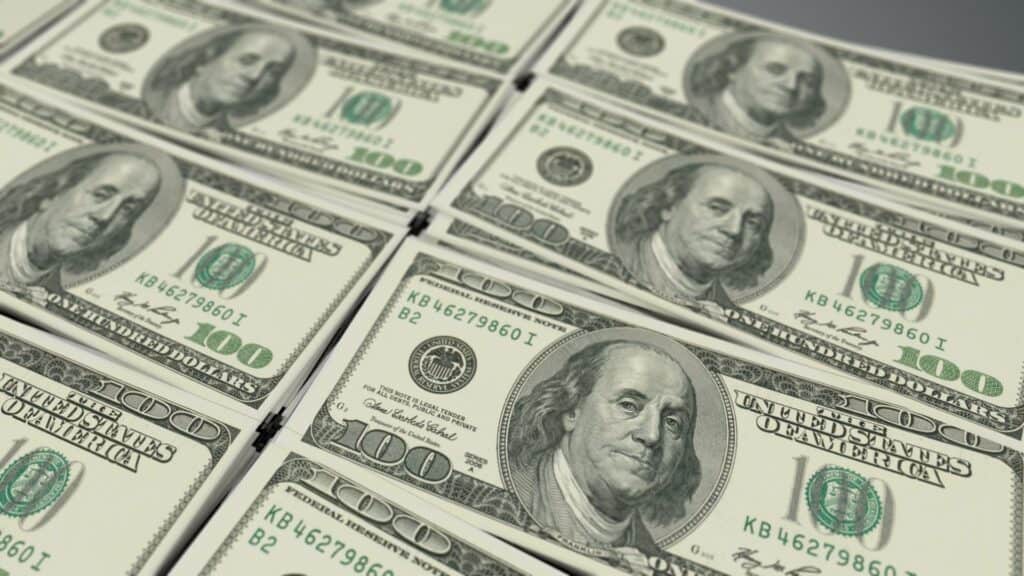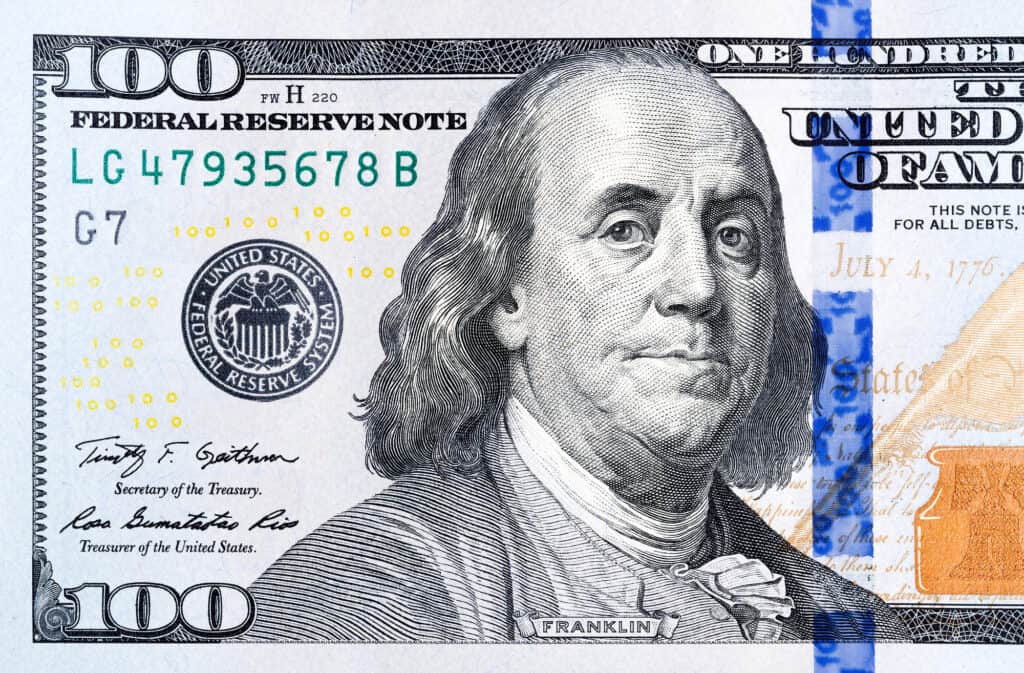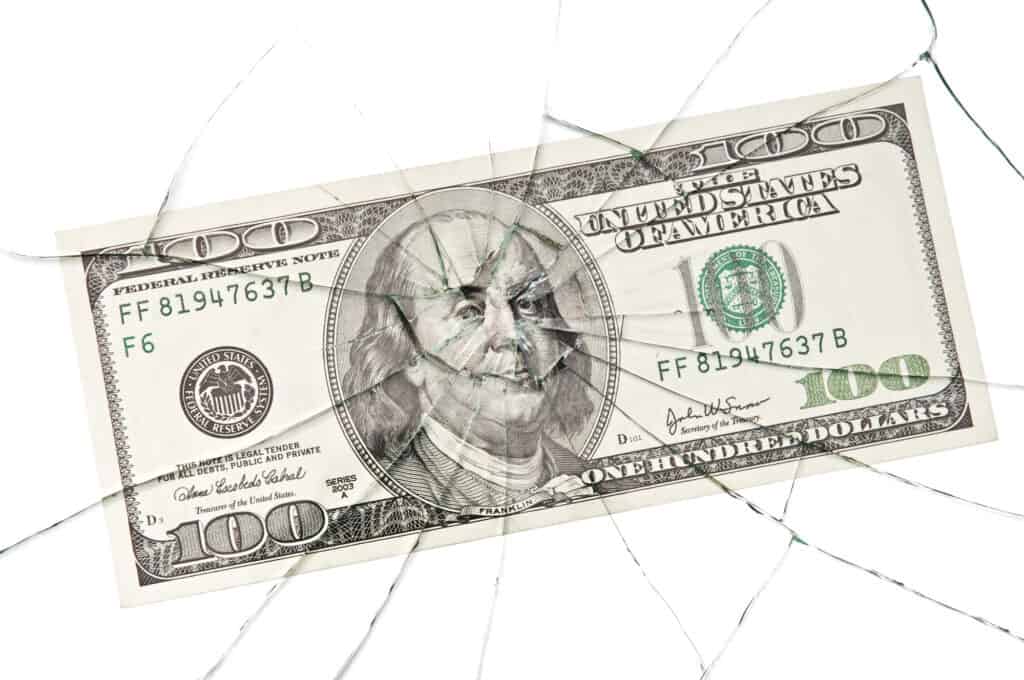Printable 100 Dollar Bill Actual Size
You are here: Home / Cold Hard Facts / Are All 100-Dollar Bills The Same Size? (Everything To Know)

Have you ever looked at the money in your wallet and wondered if it is all the same size?
Doesn't it seem like sometimes the cash fits in there easily, and other times, it can be a challenge?
If you have ever contemplated the size of money, we are here for you with some interesting facts to help get your questions answered.
Are All 100-Dollar Bills the Same Size?

Yes, all 100-dollar bills are the same size.
The size of all paper money is regulated and must be the same from one bill to the next.
The size of the 100-dollar bill is one of the methods used to help people determine if their money is real or counterfeit.
The actual size of the 100-dollar bill is 6.14 inches by 2.61 inches.
The 100-dollar bill is also made of 25 percent linen and 75 percent cotton.
The thickness of the bill is .0043 inches.
These specifications are used not only to make 100-dollar bills but to make all paper money.
The 100-dollar bills are made at mints across the United States, but they are all made with the same color green.
Where Are 100-Dollar Bills Made?

If you look at a 100-dollar bill, it will tell you where it is made.
The serial number on each bill has a letter code next to it.
The letter code represents the location where the money was made.
Some of these locations include Boston, New York City, Atlanta, and Kansas City.
Many people think money is only made in Washinton D.C., but this is not the case.
Take a look at some of the cash lying around the house and see if you can figure out where it originated.
Is There a Bill Bigger Than a $100 Bill?

As we mentioned, as far as size is concerned, all bills are going to be the same size.
If, however, you are curious about the denomination and whether there is a bill larger than $100, it depends on the time period.
Currently, in America, the $100 bill is the largest in production.
In years past, there were several other larger bills produced.
These larger currencies have been discontinued.
The discontinued bills are still worth money, sometimes even more than their face value as collector's items.
What Bills Have Been Discontinued?

At different points in history, the U.S. Mint has decided to make varying denominations.
You have more than likely come across a $2.00 bill at some point in your life.
In fact, $2.00 bills are still in circulation today even though they are not still being produced.
There are more than one billion $2.00 bills still out there.
For many years, there were $500 and even $1000 bills being produced by the government.
The interesting fact about these large bills is that, with the inflation rate, you would think they would be more useful now than in the time they were around.
Think about what $1000 could have bought you in the '60s?
Indeed, you could get much more for your money at that time.
In today's world, the highest denomination is a $100 bill, and as we all know, $100 doesn't get you all that far in 2020.
How Can You Tell if Your 100-Dollar Bill Is Real?

Newer 100-dollar bills have quite a few security measures in place to make sure they are not illegally reproduced.
There are a few key things you can look for in a 100-dollar bill to make sure they are real.
1. Blue Ribbon
For bills produced after 2013, you will see a blue ribbon across the top.
The ribbon stands out quite prominently, so you can recognize it at a glance.
2. Ben Franklin
If you rub Ben Franklin's shoulder, you will feel that the texture of the bill is raised.
The raised texture is hard for people to reproduce the exact way the U.S. mint does it.
3. MicroPrinting
There are some places on the bill where you will see the United States of America printed in very fine print.
These areas are usually around Ben Franklin, and it may take a magnifying glass for you to be able to see them.
When you compare a $100 bill today to one from years past, you will see that they are almost nothing alike.
Will Cash Become Obsolete?

Cash has always been a very popular way of conducting business.
As much as people use credit cards and electronic payments, there are still quite a bit of cash transactions that go on every day.
With the COVID-19 pandemic, less and less cash is being used.
People are looking for ways to conduct business without having to touch other people and spread germs.
With the fear of spreading germs, there is undoubtedly more and more business taking place electronically.
Most experts have believed that, at some point, cash would become obsolete, but it may happen a bit sooner than previously predicted.
There will likely be options for people to pay cash at most locations, but in the past six months, many businesses have stopped accepting cash altogether.
This is excellent news for payment processors and credit card companies but not so much for people who like to deal with cash on a day-to-day basis, or those who are paid in cash.
How Do I Replace a Damaged 100-Dollar Bill?

If you accidentally rip your 100-dollar bill, you may be able to get a replacement.
If your bill is ripped in half, you can tape it and bring it to a bank.
The bank will check the serial number, and if it is a match, they will give you a replacement bill.
If you have a 100-dollar bill and part of one end came off, you may still be able to get a new one.
Generally speaking, about 75 percent of the bill must be intact for you to be able to get a replacement for it.
Printable 100 Dollar Bill Actual Size
Posted by: haugcrichown.blogspot.com
Source: https://www.thecoldwire.com/are-all-100-dollar-bills-the-same-size/

0 Response to "Printable 100 Dollar Bill Actual Size"
Post a Comment